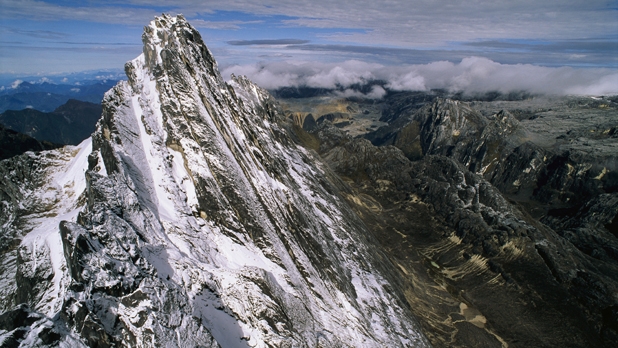Puncak Jaya
PUNCAK JAYA, THE highest peak of the Sudirman Range of Papua, is also the highest mountain between the ANDES and the HIMALAYAS, rising to 16,503 ft (5030 m) on the tropical island of New Guinea. It was first named Mount Carstenz after the Dutch navigator Jan Carstenz, who first sighted the peak from the coast in 1623. When the Dutch handed western New Guinea to INDONESIA in 1960, the peak was renamed Puncak Jaya, or “Victory Peak.” Although Puncak Jaya is located close to the equator, it is high and wet enough to support some small glaciers within approximately 2.8 square mi (7.2 square km) of snow-covered area, stretching from about 1,000 ft (305 m) below the peak. At this height, daytime temperatures vary from 75 to 45 degrees F (7 to 24 degrees C), with frequent rainfall in the afternoons and evenings accompanied by strong winds. The peak was first climbed in 1962 by the renowned Austrian mountaineer, Heinrich Harrer, who lived for a year among the local Dani tribesmen. Since the early 1960s, these tribesmen, who traditionally adorn penis guards (koteka), have continued to become a popular subject for photojournalism.

The area is surrounded by unexplored rainforests which makes travel difficult, while it provides effective hideouts for a rebel group called Organisasi Papua Merdeka (OPM), or the Papua Liberation Organization, which is waging a guerrilla campaign for independence from Indonesia. OPM's struggle can be traced to the New York agreement signed in August 1962 by representatives of the NETHERLANDS, Indonesia, the United Nations, and Papua. Another agreement signed in Rome, Italy, in May 1963 provided that West Papua would gain independence after 25 years of administrative guidance from Indonesia. While the failure of Indonesia to abide by the terms of the agreements was viewed as imperialistic, Papuan resentment is aggravated by the mining concession given to a U.S. corporation, which operates a large copper mine 18 mi (30 km) to the south of Puncak Jaya. The operation is alleged to have caused serious environmental pollution problems at the expense of the local inhabitants.
Visitors who choose to explore Puncak Jaya can begin their trek uphill from the last airstrip at Illaga village, proceeding on a tough trail for about six days through a cloud-misty rainforest, hilly terrain, muddy trails, and highland swamp and crossing streams with rain showers typically pouring four to seven hours a day. The return journey takes four days before the visitor boards a charter plane that flies directly to Jayapura, the provincial capital of Papua. As one of the “seven summits” of the world, Puncak Jaya attracts intrepid Westerners every year. The unique culture of the isolated hill tribes of central New Guinea is an added attraction to any visit to the area.